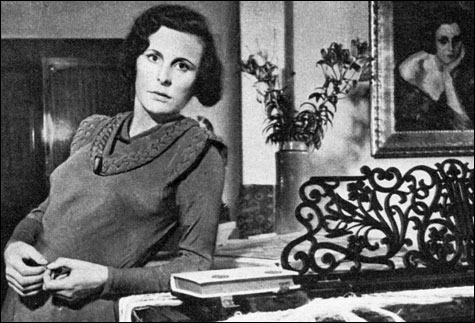
Star Wars and The Lion King quote Riefenstahl, and advertising art — from Calvin Klein to the Gap and Abercrombie & Fitch — reflect her aesthetic in a way that’s so ingrained we hardly notice. |
The past quarter-century has reveled in the increasing detail of the tell-all biography — from Christina Crawford’s 1978 gold standard, Mommie Dearest to In Touch Weekly’s “Britney’s Gay Secret: Shocking Revelations About Her Lesbian Flings” — so it’s tempting to see two new biographies of Leni Riefenstahl and assume they’ll push the envelope, and expose the dirt about her personal life. Of course, we already know she was a Nazi sympathizer who supported the Third Reich with the brilliant propaganda films Triumph des Willens (“Triumph of the Will”) and Olympia. We know she was rumored to be Hitler’s girlfriend. We know she was accused of removing adult and child Gypsies from Maxglan, a concentration camp for those who would die in Auschwitz, to use as extras in Tiefland (“Lowlands”), only to send them to their deaths when filming was finished.
So is there any shocking, new information in these biographies from Stephen Bach and Jürgen Trimborn? Well, there is a great episode, generally unnoted in the Riefenstahl mythology, that in 1938, when Riefenstahl arrived in Hollywood expecting to be lauded as a genius but instead was shunned as a Nazi, one of the few people to be at all supportive of her was Walt Disney. But even this isn’t a real surprise, since we already know that Disney, who was obsessed with the negative “Jewish influence” on Hollywood, regularly attended American Nazi Party meetings before the United States entered the war.

Her Disney friendship aside, Riefenstahl has occupied a central, or at least peripheral, position in 20th-century cinema. No question she’s an authoritative director: Triumph des Willens and Olympia are mesmerizing and powerful films. But her National Socialist politics — which she vehemently denied from after the war until her death in 2003, at age 101 — have been a stumbling block, to say the least. Germany has always treated her with the utmost caution; she could not deny her close association with the Third Reich, and her de-Nazification hearings were thought by many to be a sham. In the United States, however, she’s been less-severely critiqued. Indeed, a flurry of Riefenstahl admiration — the 1973 publication of her The Last of the Nuba, a book-length photographic essay on the “primitive” African people; an invitation to the 1974 Telluride Film Festival; her well-publicized connections to Mick Jagger and David Bowie — prompted Susan Sontag to write her 1974 essay “Fascinating Fascism,” a forceful analysis and denunciation of Riefenstahl and her “fascist aesthetics,” which Sontag describes as, in part, the idolization of masculine power and the glorification of the perfected virile body.
In content and even analysis, these new biographies — Trimborn’s was actually published five years ago in Germany and has just now become available in English — are similar. Both document Riefenstahl’s life and career; both grapple with her post-war attempts to distance herself from Hitler and Goebbels and rehabilitate her reputation.
Born Helene Bertha Amalie Riefenstahl in Berlin in 1902, she started out as an interpretative dancer, but after sustaining a knee injury she began to act in “bergfilme” (mountain films), a genre that glorified the German landscape as well as humanity’s (well, Germany’s) never-ending struggle against the forces of nature. She had an athletic sexiness that turned the genre into softcore nature porn and made her a popular obsession. (Bach spends more time on this aspect of Riefenstahl’s career than does the German-born Trimborn.) In 1932 she directed her first film, Das blaue Licht (“The Blue Light”). Casting herself as a poor mountain girl who discovers a grotto filled with crystals only to have them destroyed by greedy villagers, Riefenstahl got terrible reviews in her homeland but won the Silver Medallion at the Venice Biennial.
It was also in 1932 that she wrote a fan letter to Hitler asking to meet him; he responded, and she got the career boost she was looking for. This was not just the coincidental “pay off” from a fan letter. Riefenstahl was a true Hitler follower, as Trimborn notes, and being in his presence was almost sexual for the young director: after hearing her first Hitler speech, “hours later she was still so shaken and confused that she was unable to hail a cab.” She herself wrote, “It was as if the earth opened up before me — as if the hemisphere suddenly split down the middle and out of it erupted an enormous waterspout, so powerful that it touched the sky and shook the earth.” Talk about “was it good for you?” It was love — and career — at first sight.